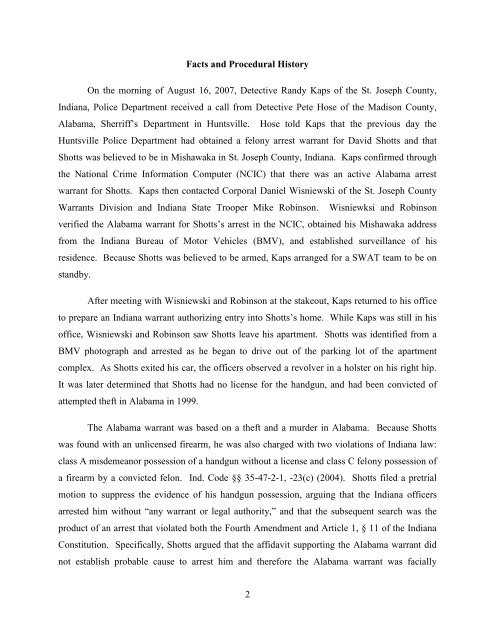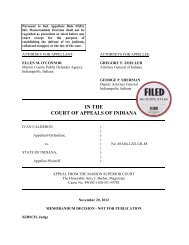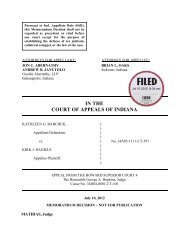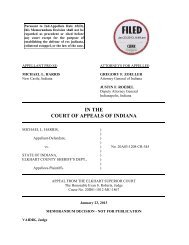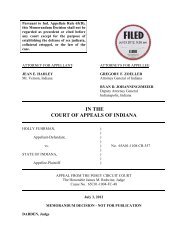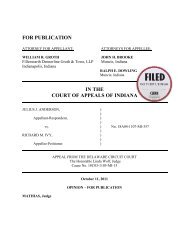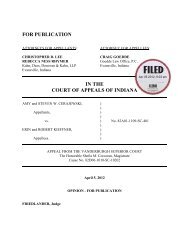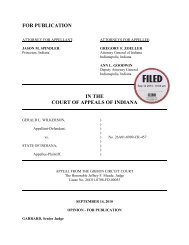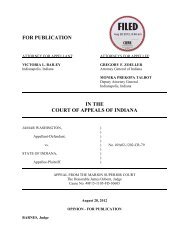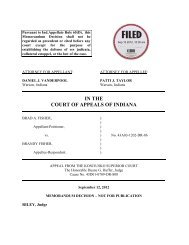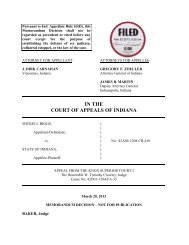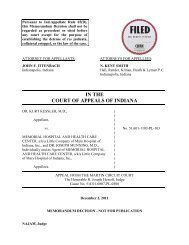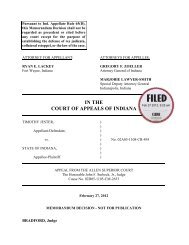David A. Shotts v. State of Indiana
David A. Shotts v. State of Indiana
David A. Shotts v. State of Indiana
Create successful ePaper yourself
Turn your PDF publications into a flip-book with our unique Google optimized e-Paper software.
Facts and Procedural History<br />
On the morning <strong>of</strong> August 16, 2007, Detective Randy Kaps <strong>of</strong> the St. Joseph County,<br />
<strong>Indiana</strong>, Police Department received a call from Detective Pete Hose <strong>of</strong> the Madison County,<br />
Alabama, Sherriff‘s Department in Huntsville. Hose told Kaps that the previous day the<br />
Huntsville Police Department had obtained a felony arrest warrant for <strong>David</strong> <strong>Shotts</strong> and that<br />
<strong>Shotts</strong> was believed to be in Mishawaka in St. Joseph County, <strong>Indiana</strong>. Kaps confirmed through<br />
the National Crime Information Computer (NCIC) that there was an active Alabama arrest<br />
warrant for <strong>Shotts</strong>. Kaps then contacted Corporal Daniel Wisniewski <strong>of</strong> the St. Joseph County<br />
Warrants Division and <strong>Indiana</strong> <strong>State</strong> Trooper Mike Robinson. Wisniewksi and Robinson<br />
verified the Alabama warrant for <strong>Shotts</strong>‘s arrest in the NCIC, obtained his Mishawaka address<br />
from the <strong>Indiana</strong> Bureau <strong>of</strong> Motor Vehicles (BMV), and established surveillance <strong>of</strong> his<br />
residence. Because <strong>Shotts</strong> was believed to be armed, Kaps arranged for a SWAT team to be on<br />
standby.<br />
After meeting with Wisniewski and Robinson at the stakeout, Kaps returned to his <strong>of</strong>fice<br />
to prepare an <strong>Indiana</strong> warrant authorizing entry into <strong>Shotts</strong>‘s home. While Kaps was still in his<br />
<strong>of</strong>fice, Wisniewski and Robinson saw <strong>Shotts</strong> leave his apartment. <strong>Shotts</strong> was identified from a<br />
BMV photograph and arrested as he began to drive out <strong>of</strong> the parking lot <strong>of</strong> the apartment<br />
complex. As <strong>Shotts</strong> exited his car, the <strong>of</strong>ficers observed a revolver in a holster on his right hip.<br />
It was later determined that <strong>Shotts</strong> had no license for the handgun, and had been convicted <strong>of</strong><br />
attempted theft in Alabama in 1999.<br />
The Alabama warrant was based on a theft and a murder in Alabama. Because <strong>Shotts</strong><br />
was found with an unlicensed firearm, he was also charged with two violations <strong>of</strong> <strong>Indiana</strong> law:<br />
class A misdemeanor possession <strong>of</strong> a handgun without a license and class C felony possession <strong>of</strong><br />
a firearm by a convicted felon. Ind. Code §§ 35-47-2-1, -23(c) (2004). <strong>Shotts</strong> filed a pretrial<br />
motion to suppress the evidence <strong>of</strong> his handgun possession, arguing that the <strong>Indiana</strong> <strong>of</strong>ficers<br />
arrested him without ―any warrant or legal authority,‖ and that the subsequent search was the<br />
product <strong>of</strong> an arrest that violated both the Fourth Amendment and Article 1, § 11 <strong>of</strong> the <strong>Indiana</strong><br />
Constitution. Specifically, <strong>Shotts</strong> argued that the affidavit supporting the Alabama warrant did<br />
not establish probable cause to arrest him and therefore the Alabama warrant was facially<br />
2


